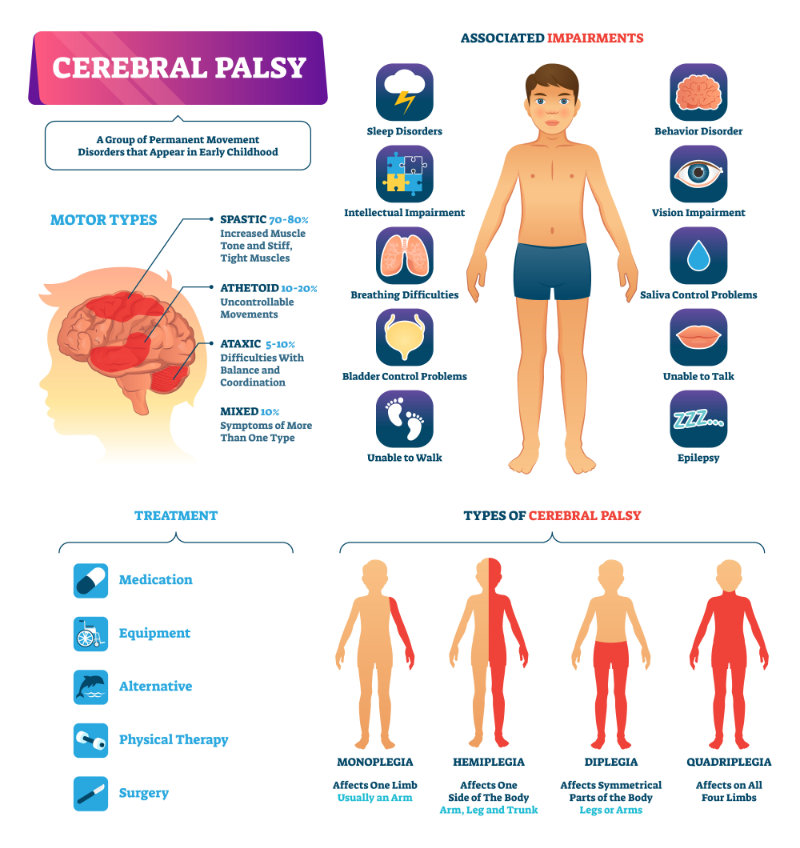Initially, a patient will undergo a nursing assessment, during which the nurse will interview the child and family to determine the child’s needs. They will also observe the child's level of development. Both of these components will be used to establish realistic long-range goals for nursing care (Belleza, 2024). The nurse will also take a complete patient history and perform a neurological and muscular examination. Using all of the information gathered, they will create a plan of care. Certified Nursing Assistants (CNAs) and Home Health Aides (HHAs) often play a vital role in this plan of care.
CNAs and HHAs play a key role in helping people with CP. They help with daily activities, including bathing, dressing, and eating, as well as with movements, such as transfers and walking.
They also help provide skin care, pain management, seizure monitoring, and proper positioning. Assisting with ADLs is important. CNAs and HHAs help people with CP do these tasks while allowing them to be as independent as possible.
Some people with CP may have trouble eating and may need nutritional support and feeding assistance. CNAs, HHAs, and HHAs help them eat safely and assist with the use of special utensils (Cerebral Palsy Guide, 2025).
Some people with CP have trouble with bowel and bladder control. CNAs and HHAs help provide bowel and bladder care. Skincare and pressure ulcer prevention are important. People with CP may spend a lot of time in one position. This can cause skin breakdown and the formation of pressure ulcers (Cerebral Palsy Guide, 2025). Preventing pressure ulcers is an important aspect of skin care for people with CP.
Therapy and rehabilitation are key parts of care for people with cerebral palsy. CNAs' and HHA's therapy goals are to assist with exercises and activities that enhance movement and daily living skills. It is important to help stay motivated and create a positive environment. A CNA and HHA should encourage people with CP to do their best and help them celebrate small wins.
CNAs and HHAs have a responsibility to:
- Follow the patient's care plan: This ensures consistent and appropriate care.
- Provide safe and respectful care: Patients have the right to be treated with dignity.
- Help people with CP be as independent as possible: Encouraging self-sufficiency is important.
- Help them participate in their community: Social inclusion is vital.
Mobility and positioning are very important for people with cerebral palsy. CNAs and HHAs and HHAs help with safe transfers and ambulation, assisting individuals in moving from one location to another. The use of assistive devices like walkers and wheelchairs may be used to help with moving. It is important to use proper body mechanics during transfers to prevent injury to the patient, as well as the CNA or HHA.
Proper positioning techniques are also important. People with CP may have tight muscles, which can cause problems with posture. It is crucial to help them sit and lie in good positions using pillows and support. This helps prevent pressure ulcers and contractures(Cerebral Palsy Guide, 2025). Contractures are when muscles tighten and shorten, and they can become stuck and cause mobility to decline. Assistive devices like braces and splints can be used to help prevent deformities.
Promoting independence in Activities of Daily Living (ADLs) is vital for those with cerebral palsy. CNAs and HHAs assist with bathing, dressing, eating, and toileting. They also encourage individuals with CP to do as much as they can on their own.
Break tasks into smaller steps. Use assistive devices like adaptive utensils, dressing aids, and grab bars.
Safety is important when caring for people with cerebral palsy (CP). Certified Nursing Assistants (CNAs and HHAs) must make sure the home is safe. This means:
- Looking for hazards: Hazards are anything that could cause injury.
- Removing hazards: CNAs and HHAs must take steps to eliminate these dangers.
- Ensuring good lighting: Proper lighting helps prevent falls.
- Preventing tripping hazards: CNAs and HHAs should keep floors clear of obstacles.
- Making sure the person can move safely: This includes arranging furniture for easy movement.
- Helping with safe transfers: CNAs and HHAs must assist with moving the person safely.
- Using proper body mechanics: This helps prevent injuries to both the CNA and the patient.
- Using assistive devices safely: Devices like walkers and wheelchairs must be used correctly.
Preventing infections is also crucial (National Institute of Neurological Disorders and Stroke, 2025). People with CP may have weaker immune systems, making them more likely to get sick. CNAs and HHAs must:
- Wash their hands often: Good hand hygiene is essential.
- Use gloves when needed: Gloves protect against germs.
- Clean surfaces: Regular cleaning helps prevent the spread of infection.
- Follow infection control rules: These rules are designed to prevent illness.
- Report any signs of infection: Early reporting helps with prompt treatment.
- Follow the care plan: The care plan outlines specific safety and infection control measures.
- Work with the healthcare team: Communication is vital for coordinated care.
Being careful, clean, and following all safety rules is essential for the well-being of the person with CP.








